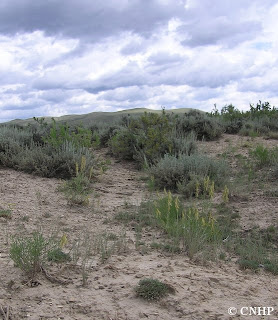CNHP Botany Information Manager Jill Handwerk took these photos of the federally endangered Osterhout milkvetch (Astragalus osterhoutii) earlier this summer. This member of the pea family grows on highly seleniferous (containing the element selenium) soils derived from Niobrara Shale in Grand County. It is a narrowly endemic species estimated to occupy about 800 acres in north central Colorado.
A few dozen species of Astragalus, including A. osterhoutii, have been identified as “selenium indicators”, accumulating the element in their tissues as they grow on seleniferous soils. In the early decades of the 20th century, selenium was identified as the underlying cause of “alkali disease” which affected livestock that were fed grains or grasses grown on certain soils. Selenium gives a characteristic and lasting garlic-like odor to the plants, and herbarium workers can always tell when someone has opened the cabinet containing these specimens.

Not many plants can grow in such heavy shale soils, but A. osterhoutii likes it





No comments:
Post a Comment
Thanks for your comment!
Please note that all comments are moderated, so there may be a delay of some hours (especially over the weekend or at night Colorado time) before your comment shows up.